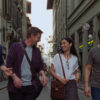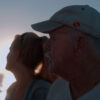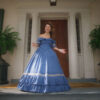Growing up in St. Petersburg, Florida, Amy Seimetz recalled being cautioned in elementary school that should she ever be kidnapped, “Don’t do things like scream because men get off on that.”
Although Seimetz survived the sweltering heat “that makes everyone crazy and violent” long enough to learn why that was such an unusual warning to a prepubescent, it’s no wonder the actress-turned-director had a recurring nightmare in which she envisioned herself helping a lover on the lam. What is wondrous is how Seimetz took her fear and turned it into “Sun Don’t Shine,” a taut, tense tale of a dimwitted couple (played by “Open Five” writer/director Kentucker Audley and “Green” star Kate Lyn Sheil) who can be seen in the film’s opening moments wrestling each other in the mud, only to grapple with one another in far murkier territory once they return to the road in a beat-up Buick with something to hide.
However, they aren’t the only ones making a break for it, the pedal-to-the-metal drive from Tampa to the Everglades a refreshing change of pace for the group of filmmakers behind it as well. Drawing on the naturalism of their earlier films often centered around the usual pursuits of twentysomethings, or lack thereof, “Sun Don’t Shine” is a thrill ride heightened by Audley and Sheil’s rich, fearless characterizations of the desperate pair and Seimetz’s nearly tangible evocation of the panhandle, shooting on film as opposed to digital make it soak through the screen as the sweat does through Audley’s wife-beater.
For one of the best-kept secrets at this year’s SXSW Film Festival, it’s only natural that Seimetz would like to keep some others about the film’s production as well as the story, but as audiences are able to catch the film this week at the Sarasota Film Festival, we were able to wring out a few stories from the writer/director, Audley and Sheil about how “Sun Don’t Shine” came together, the challenge of filming inside a car for much of the shoot and how Shane Carruth, the elusive director of “Primer,” came onboard to design the film’s closing credits.
When you see the gun fall out of the glovebox, you think this is something different for everybody involved. Was it intentional on your part to shake it up a bit?
Amy Seimetz: We actually had a meeting at SXSW last year. We went and had lunch and we were talking about it and I think I told you guys that roughly I thought abusive men deserve to be killed [laughs]…
Kentucker Audley: As a starting point.
AS: That was it and then lunch was over. [laughs] But I did say that and I also said, I don’t condone killing, but we talked about how we wanted to make something that was just nonstop, tense and aggressive…
KA: With plot points…
AS: And a strong plot. Kentucker and I talked about all these ideas and the best one was this recurring nightmare I’d been having.
KA: Once Amy and I started throwing out ideas, my initial feedback was to keep it [tied] very directly [to] the nightmare, so we could make this quickly in that day. The incredible depth of having this nightmare for years, there was so much material to draw from and the narrative was already so embedded in the dream, so it could happen quickly. Since we were excited to work together and with Kate, the simplicity of the story and just basing it off a dream was very fundamental in the pre-production part of it.
Something interesting Amy said after the screening was how it’s assumed that you keep working with each other because you’re friends, but in reality it’s because you’ve worked together so much there’s a trust between you. That must’ve been crucial for a film like this that starts out with mud wrestling.
KA: The bottom line is that we’re all very kindred connections and we all respect each other’s work. We trust each other’s instincts to the level it doesn’t matter where we’re going. If we have to fight in the mud, let’s do it. There’s no questioning our commitment to one another in order to create something together and it’s just exciting as far as we can push it, we can push it and our trust is deep, even though we haven’t known each other for that long.
Kate Lyn Sheil: It’s motivating also to work for these two, to want to give the best that you can for them. I think everybody was aware this was special.
KA: So we can take the risks that I think we all feel is very necessary to create a lasting and exciting piece of art.
KS: That’s something we talked about at that first lunch also was just wanting to do something we felt really risky about.
Speaking of risks, what was it like to have a car as a set?
AS: That was my boyfriend’s car that we were using and when you open it, you open the trunk with a screwdriver, you start it with a screwdriver…but it ran great. It would overheat every once in a while, which made it into the script, but I worked with the car before also. [laughs]
KS: You trusted the car.
AS: Yeah, I trusted the car. But the famous quote about “Two-Lane Blacktop” is that they figured out more ways to shoot a car than any other film that had ever been made. And Jay [Keitel, the director of photography] and I were like “we’re going to figure out a different way. We’re going to top them.” And I promised him I wouldn’t tell anyone this trick, but we figured out a trick on how we’d get some crazy angles in the car with very, very limited means. Also, we were strapping Jay to the car.
KA: On various occasions of him hanging out of the car.
AS: He’s a really ballsy cinematographer in a lot of ways.
KA: I was a really ballsy driver, don’t you guys think? Let’s not give Jay too much credit. I was on the road…[laughs]
Being in such a tight enclosed space, was that especially intense for you as actors?
KS: You couldn’t escape where you were really. You were in this very specific physical space and the way the car felt, how hot it was, everything was informative to performances.
KA: It was claustrophobic and I personally am fidgety and can’t sit still, but I felt very restrained in either be focused on driving as well or just be physically confined to not being able to go here because I’d be running into the camera, so it was a huge challenge for me personally to have so much of it shot in the car. But the flipside of that is being focused on other things is also very helpful to an actor to lose yourself in an actual activity that you’re doing.
The Florida setting is so integral to the tension in the film and it seems in general, getting the South right is difficult for films. Did you feel there were things you could do in this film better than you had seen in other films?
AS: It’s not necessarily in the marketing of our film because I didn’t want to put it in people’s face that it’s a Southern movie, but definitely in the photography of it and the locations that we shot, [it has] a Southern Gothic sort of feel, mixed with this swampland. The reason a lot of times I have a hard time with Southern movies or why they don’t get it right is because they’re constantly reminding me that I’m in the South. There’s always some character that comes out and says, “Y’all ain’t from around here, are you?” But in Florida, it’s more the eeriness of this landscape that people aren’t really supposed to live in – it’s swampland that they irrigated and built housing developments out of.
KA: The key to capturing any geographic location as far as I’m concerned is to not make a point of showing it. You point the camera this way, it’s captured.
AS: It’s also that we live in these places. I’m very intimately connected to that world, it’s like my secondhand and when I go live in New York or California, these are the things that I miss. I can hear the cicadas. There’s Palmetto trees and certain smells and sounds and the way you feel, like you sweat immediately — there’s just certain specific elements we wanted to show because these are specific to Florida, but all I ever see in Florida movies are like palm trees and beaches.
The choice to shoot on film as opposed to digital seemed to make it more sweaty.
AS: Like gritty and dirty. It feels dirtier in a way.
You can’t say that about the end credits however, which are elegant and beautifully incorporate the sun-dappled color palette of the film as a whole. They also happen to be the first onscreen credit for Shane Carruth since he directed “Primer.” [He also recently helped with the visual effects on Rian Johnson's upcoming time-travel thriller "Looper."] So how did he get involved both in designing the credits and attaching his name as an executive producer?
AS: We did another project together that we’re not allowed to talk about. [She asks someone sitting nearby.] But half the reason we worked together was because he watched a cut of my movie and was really excited about it. And we needed to finish the movie and he was happy to help us out.
How did you collaborate on the credits sequence?
AS: How can I talk about Shane? I can say this…what I like about Shane and everyone that I’ve ever collaborated with like Kentucker or Kate or Jay, my [director of photography], is that the idea of having an expert is like bunk to us. [To get our credits done], we had to go to this place to have our titles done and we’re like, “What do you mean they put it through a program?” I can do that. Give me a day to figure out a program and I’ll do it myself. And [Shane’s] the same way. I knew [the credits] would be really easy. And he was like, “Oh, I’ll just do it.” So he just did the credits for me. [laughs] I gave him the font, I told him what I wanted, which was I said I think you should print them out on a sheet and take a photograph of them and reimport them and then he designed them.
KA: You did the painting stuff?
AS: No, he did all that. He wanted to. He was really stressed out about his other stuff and he was like, “I really want to do this because I want to focus on something else.”
Amy, since you’re from Florida, did you enjoy the culture clash of bringing a cast and crew down that may not have been familiar with your native soil?
AS: Yeah, we shot at this really seedy bar and we got there at eight in the morning, so they got to see an interesting side of the Florida barfly. And also, I took them on the river and I’m like just jumping in and Kim Sherman, our producer, was like “I don’t think you should do that until we make sure there’s no alligators in there?” I’m like, “Oh, they won’t come in here.” [turns to Sheil and Audley] I was totally lying, guys. Alligators would totally go there.
"Sun Don't Shine" is now open at the Cinema Village in New York and available on VOD. A full list of release dates can be found here.



